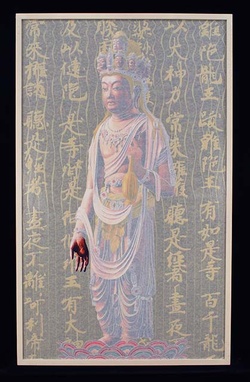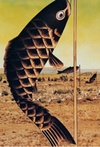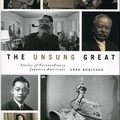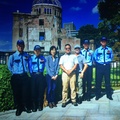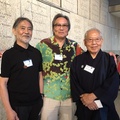“I used to profess to my students that all photographs lie,” says Patrick Nagatani.
The longtime artist and art professor is then quick to express a “wiser attitude” toward photography. “The statement is a bit anthropomorphic as photographs are but inanimate objects left to interpretation by the artist and viewer.”
“My approach today dwells in an ironic state of middle ground,” he says. “Possibly one negative in our culture today is the attitude that things must be fact or fiction, good or bad, truth or lies, black or white, right or wrong, all or nothing, big or small, expensive or cheap, violent or docile, and so on. This kind of thinking leaves no room for magic and possibilities in creative endeavor that might be in the gray area or middle earth.”
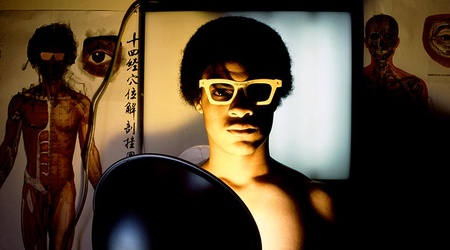
"Marcus - Instant Cultural Vision - Chromatic Optometry Los Angeles, California," 1978/2004. Courtesy of Patrick Nagatani
The search for that magic—the elusive but powerful force that sparks creativity and inspiration—has been a recurring theme in Nagatani’s art. His work is now the subject of a new traveling exhibition, Desire for Magic: Patrick Nagatani 1978-2008.
“The world of magic exists in parallel with our own non-magic one,” Nagatani says. “I try to embrace the world of magic in my work. White magic, black magic, dreams, nightmares, stories, lies, dragons, fairies, blue-bearded genies, speaking dogs, color healing, buried cars, buried treasures, music, fiction, hope, fear, the angel of death, the angel of love, interruptions, jokes, facade, good ideas, rotten ideas, happy endings, in fact almost everything of any interest at all.”
“I am a storyteller with images,” Nagatani remarks.
For Nagatani, who credits his mentor, Robert Heinecken, for encouraging him to break from conventional artistic thinking, creating imagery is not limited to photography. Some of Nagatani’s most provocative work has involved the use of a most unexpected medium.
Masking tape.
Through his Tape-estries—artworks meticulously fashioned from cut and layered pieces of masking tape—Nagatani marries the visual with the tactile. The results are often striking images of Buddhist bodhisattvas, and he speaks passionately about the experience of crafting each piece.
“The process is like driving from Albuquerque to Los Angeles non-stop,” says Nagatani. “It’s like being in shape and running ten miles. It’s like chanting. It’s like doing all the movements of tai chi the meditative way. It’s about finding a zone of no thought. Time passes and only my aching fingers and shoulders indicate how long I have been continuously painting with the tape. I relish the focus on details and to be lost in the quiet and minute parts of the whole. Decisions are mostly made as a reaction to the materials, the image and the emotive feel.”
“The taping process is obsessive,” he says. “It is done with precision and ardor. Masking tape is a simple material. I use every variety of masking tape that is commonly available. The subtle color of the tape creates my range of hues for my ‘painting’ palette. There are varying degrees of translucency and the amount of layers dictate a value shift. The tearing and cutting parodies a variety of ‘brush strokes.’”
“Time is a factor,” he adds. “It must take long sessions to get to the zone. After each session there is another zonal journey. Clarity often comes after a long session. More things are revealed to me after each session. Magic is a goal. My entire day is shaped by solitude and what I believe is constructed beauty. I want magic in my life and work.”
“I have often desired the overlay of sensory experience in my work,” says Nagatani. “These pieces require looking from afar and getting in very close, both vantage points offer differing visual experience. The pieces are wonderful to touch.”
“My ‘tapist’ career started in 1983 and the pieces made at that time have lasted throughout the years,” says Nagatani. “I believe that the pieces have a life of their own and will change very slowly in time, much like mummies from ancient Egypt have lasted through the centuries but nevertheless have changed. The work might be seen as an evolving entity with the spirit of permanence and impermanence interwoven into the materials used in the artistic process.”
“Beauty is important,” Nagatani says. “Constructed in the simplest of ways, I believe that these are among the most beautiful pieces that I have created. I relish the fact that the tape is an inexpensive and somewhat castaway art material. The Zen of the material and process moves me to a spiritual happiness.”
Nagatani credits the joy of art with helping him to face health issues that have challenged him over the years.
“Most things seem to now have a place in the cosmic meaning of things. Especially in coping with getting older and dealing with cancer,” he says. “With a big brush with cancer…I treasure each day in the studio.”
“I’ve been in the zone off and on for over 29 years with this work,” he says. “It has been positive energy for me. It has left me no room or desire for negative creative existence.”
It has left him with only further desire for magic.
* * *
Desire for Magic: Patrick Nagatani
November 19, 2011 - January 15, 2012
Japanese American National Museum
The exhibition is a unique opportunity to see both the extensive range of Nagatani’s directorial approach and the breadth of his color photography as he addresses issues surrounding the human condition; politics and the fragile, ever-changing environment; concerns about identity and self; and the invention and interpretation of history.
To read more about Patrick Nagatani >>
© 2011 Japanese American National Museum


